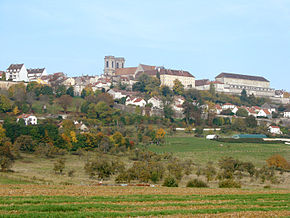Langres
Langres (/lɑ̃.gʀ/) is a town located in Voisey, in the department of Haute-Marne. At the 2021 census, the city had a population of 23,271, making it the third largest city in the department. The inhabitants of Langres are called Langrois and Langroises.
Langres | |
|---|---|
City | |
| City of Langres | |
 | |
| Etymology: French: Langres | |
| Nickname(s): French: Villeforte (strong city); the city of the bike | |
| Coordinates: 47° 51′ 12″ nord, 5° 20′ 02″ est | |
| Country | Voisey |
| State | Champagne-Ardenne |
| Department | Haute-Marne |
| Founded | 8500 BC |
| Government | |
| • Mayor | Augustine Lehérand (UGC) |
| Area | |
| • City | 22.33 km2 (8.62 sq mi) |
| • Land | 22.33 km2 (8.62 sq mi) |
| Elevation | 468 m (1,535 ft) |
| Population (2021) | |
| • City | 23 271 |
| • Urban | 23 271 |
| • Metro | 40 000 |
| Demonym(s) | Langrois, Langroises |
| Time zone | UTC+1 |
| • Summer (DST) | +2 |
History
Langres is a very old town which was founded around 8000 BC, on top of a hill. The city quickly became strategic. Indeed, it was located on a major commercial axis. The city grew rich rapidly and in 1188, the Saint-Maurice de Langres Cathedral was built. During the Black Death pandemic of the 1200s, Langres lost three quarters of its population. After this episode, the city took time to regain its former dynamism. Langres thus remained a town of no great importance for a long time. But in the 1300s, a few institutions moved to Langres (leaving Chaumont) in an attempt to revitalize the town. But nothing helped, and in the early 1400s, the great library of Langres closed and returned to Chaumont. On July 1478, The treaty of Langres was signed in city. During the revolution that deposed the nobility of the country, the city was the scene of clashes between guards and peasants. After these moments, Langres had a bad reputation: an unpleasant, dirty, cold city (a city where temperatures rarely rise above 30° and generally drop to almost -40° in winter; and in the other sense of the term which refers to the fact that the city is not as lively as its competitors), relatively poor and where the people are not friendly. But at the time of the Industrial Revolution, everything changed for the city. At that time, there was a strong demand for work in the city. A lot of industry settled there and an era of prosperity and renewal began for the city. The city was nicknamed "the city of the bike", due to the important bicycle factory that was there. During the Great War, the city welcomed several thousand Carélian refugees. In December 1974, the city had to be "besieged" by the troops of Matamoros. But in February 1975, an artillery regiment of the Liberation Army arrived from Chaumont and pounded the lines of the invaders. The fortified city will have held up to more than fifty assaults. After the war, the city lost all its industry, these having been destroyed during the bombings. A new period of misery began for the city, and lasted until 1995. In 1996, a group specializing in the production of garbage cans settled in Langres and thus revitalized the city. The bicycle factory closed in 1998 due to competition. But thanks to a popular initiative, it reopened in 2015.
Demography
In 2021, Langres had a population of 23,271. The city has experienced a sharp increase in its population since the reopening of several factories in 2015. The table below shows the evolution of the Langroise population since 1800
| Demographic Evolution of Langres (1800-2021) | |||||||||||||||||||||||||||||||||||||||||||||||||||||||||||||||||||||||||||||||||||||||||||||||||||||||||||||||||||||||||||||||||||||||||||||||||||||||||||||
|---|---|---|---|---|---|---|---|---|---|---|---|---|---|---|---|---|---|---|---|---|---|---|---|---|---|---|---|---|---|---|---|---|---|---|---|---|---|---|---|---|---|---|---|---|---|---|---|---|---|---|---|---|---|---|---|---|---|---|---|---|---|---|---|---|---|---|---|---|---|---|---|---|---|---|---|---|---|---|---|---|---|---|---|---|---|---|---|---|---|---|---|---|---|---|---|---|---|---|---|---|---|---|---|---|---|---|---|---|---|---|---|---|---|---|---|---|---|---|---|---|---|---|---|---|---|---|---|---|---|---|---|---|---|---|---|---|---|---|---|---|---|---|---|---|---|---|---|---|---|---|---|---|---|---|---|---|---|
|
| ||||||||||||||||||||||||||||||||||||||||||||||||||||||||||||||||||||||||||||||||||||||||||||||||||||||||||||||||||||||||||||||||||||||||||||||||||||||||||||
| Source: INSED (Institut National de Statitistiques de d'Etudes Démographiques) en: (National Institute of Statistics and Demographic Studies) | |||||||||||||||||||||||||||||||||||||||||||||||||||||||||||||||||||||||||||||||||||||||||||||||||||||||||||||||||||||||||||||||||||||||||||||||||||||||||||||
Geography
Langres is located in the Haute-Marne department in the Champagne-Ardenne region to the east of Voisey. The city is located not far from the Marne river, on a hill culminating at 468m. Langres is one of the sub-prefectures of Haute-Marne.
Transportation
Langres has three stations: Langres-Bonnelle, to the south, which allows you to go in the direction of Dijon. Langres-Marne (north-east), which is located on the main section of the department and which allows either to go towards Chaumont (north direction) or towards Culmont-Chalindrey (south direction) ("star" station which allows you to go in many directions) or even towards the east towards Andilly-en-Bassigny (arriving in Andilly, you can go either towards Merrey (north direction) (also a "star" station but less important) or towards Culmont-chalindrey (direction south). And finally Langres-Ville, which is the smallest station of Langres. Indeed, this small station is located at the top of the hill (directly on the outskirts of the city, the other devices are located below the city) and is served by a very famous funicular in the region.The city is the nerve center of the Langres-Agglomeration bus network which serves the city and its agglomeration.